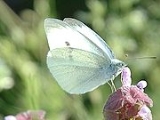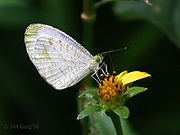
Pieridae
Encyclopedia
The Pieridae are a large family
of butterflies
with about 76 genera
containing approximately 1,100 species
, mostly from tropical Africa
and Asia
. Most pierid butterflies are white, yellow or orange in coloration, often with black spots. The pigments that give the distinct colouring to these butterflies are derived from waste products in the body and are a characteristic of this family.
It is believed that the name "butterfly" originated from a member of this family — the Brimstone Gonepteryx rhamni — which was called the "butter-coloured fly" by early British naturalists.
The sexes usually differ, often in the pattern or number of the black markings.
The larva
e (caterpillar
s) of a few of these species, such as Pieris brassicae and Pieris rapae, commonly seen in gardens, feed on brassica
s, and are notorious agricultural pests.
Males of many species exhibit gregarious mud-puddling behavior when they may imbibe salt
s from moist soils.
, and the tarsal
claws are bifid
unlike in the Papilionidae.
Like the Papilionidae, Pieridae also have their pupae held at an angle by a silk girdle, but running at the first abdominal segment unlike the thoracic
girdle seen in the Papilionidae.
According to the molecular phylogenetic study of Braby et al. (2006), sister group relationships among Pieridae subfamilies are: ((Dismorphiinae+Pseudopontiinae)+(Coliadinae+Pierinae)).

Family (biology)
In biological classification, family is* a taxonomic rank. Other well-known ranks are life, domain, kingdom, phylum, class, order, genus, and species, with family fitting between order and genus. As for the other well-known ranks, there is the option of an immediately lower rank, indicated by the...
of butterflies
Butterfly
A butterfly is a mainly day-flying insect of the order Lepidoptera, which includes the butterflies and moths. Like other holometabolous insects, the butterfly's life cycle consists of four parts: egg, larva, pupa and adult. Most species are diurnal. Butterflies have large, often brightly coloured...
with about 76 genera
Genera
Genera is a commercial operating system and development environment for Lisp machines developed by Symbolics. It is essentially a fork of an earlier operating system originating on the MIT AI Lab's Lisp machines which Symbolics had used in common with LMI and Texas Instruments...
containing approximately 1,100 species
Species
In biology, a species is one of the basic units of biological classification and a taxonomic rank. A species is often defined as a group of organisms capable of interbreeding and producing fertile offspring. While in many cases this definition is adequate, more precise or differing measures are...
, mostly from tropical Africa
Africa
Africa is the world's second largest and second most populous continent, after Asia. At about 30.2 million km² including adjacent islands, it covers 6% of the Earth's total surface area and 20.4% of the total land area...
and Asia
Asia
Asia is the world's largest and most populous continent, located primarily in the eastern and northern hemispheres. It covers 8.7% of the Earth's total surface area and with approximately 3.879 billion people, it hosts 60% of the world's current human population...
. Most pierid butterflies are white, yellow or orange in coloration, often with black spots. The pigments that give the distinct colouring to these butterflies are derived from waste products in the body and are a characteristic of this family.
It is believed that the name "butterfly" originated from a member of this family — the Brimstone Gonepteryx rhamni — which was called the "butter-coloured fly" by early British naturalists.
The sexes usually differ, often in the pattern or number of the black markings.
The larva
Larva
A larva is a distinct juvenile form many animals undergo before metamorphosis into adults. Animals with indirect development such as insects, amphibians, or cnidarians typically have a larval phase of their life cycle...
e (caterpillar
Caterpillar
Caterpillars are the larval form of members of the order Lepidoptera . They are mostly herbivorous in food habit, although some species are insectivorous. Caterpillars are voracious feeders and many of them are considered to be pests in agriculture...
s) of a few of these species, such as Pieris brassicae and Pieris rapae, commonly seen in gardens, feed on brassica
Brassica
Brassica is a genus of plants in the mustard family . The members of the genus may be collectively known either as cabbages, or as mustards...
s, and are notorious agricultural pests.
Males of many species exhibit gregarious mud-puddling behavior when they may imbibe salt
Salt
In chemistry, salts are ionic compounds that result from the neutralization reaction of an acid and a base. They are composed of cations and anions so that the product is electrically neutral...
s from moist soils.
Classification
The Pieridae have the radial vein on the forewing with 3 or 4 branches and rarely with 5 branches. The fore legs are well developed in both sexes, unlike in the NymphalidaeNymphalidae
The Nymphalidae is a family of about 5,000 species of butterflies which are distributed throughout most of the world. These are usually medium sized to large butterflies. Most species have a reduced pair of forelegs and many hold their colourful wings flat when resting. They are also called...
, and the tarsal
Tarsal
Tarsal could refer to:*tarsus *tarsus *superior tarsal muscle...
claws are bifid
Bifid
Bifid refers to something that is split or cleft into two parts. It may refer to:* bifid rib, a congenital abnormality of the human anatomy* bifid penis* bifid cipher, a type of cipher in cryptography...
unlike in the Papilionidae.
Like the Papilionidae, Pieridae also have their pupae held at an angle by a silk girdle, but running at the first abdominal segment unlike the thoracic
Thorax (insect anatomy)
The thorax is the mid section of the insect body. It holds the head, legs, wings and abdomen. It is also called mesosoma in other arthropods....
girdle seen in the Papilionidae.
Subfamilies
The Pieridae are generally divided into the following four subfamilies:- DismorphiinaeDismorphiinaeDismorphiinae is a subfamily of butterflies from the family Pieridae. It consists of about 100 species in 7 genera, distributed mainly in the Neotropical region, of which only one species occurs in North America and one genus, Leptidea, in the Palaeartic region.- Genera of Dismorphiinae :*...
(6 genera) Mostly Neotropical, this group includes several mimetical species. The host plants are in the family FabaceaeFabaceaeThe Fabaceae or Leguminosae, commonly known as the legume, pea, or bean family, is a large and economically important family of flowering plants. The group is the third largest land plant family, behind only the Orchidaceae and Asteraceae, with 730 genera and over 19,400 species...
. - PierinaePierinaeThe Pierinae are a large subfamily of Pierid butterflies. The subfamily is one of several clades of butterflies often referred to as the Whites...
(55 genera) Whites, Yellow, Orange-tips, many of these species are strongly migratory. Host plants are in the families Capparidaceae, BrassicaceaeBrassicaceaeBrassicaceae, a medium sized and economically important family of flowering plants , are informally known as the mustards, mustard flowers, the crucifers or the cabbage family....
, SantalaceaeSantalaceaeSantalaceae is a widely distributed family of flowering plants which, like other members of Santalales, are partially parasitic on other plants...
, and LoranthaceaeLoranthaceaeLoranthaceae is a family of flowering plants, which has been universally recognized by taxonomists. It consists of about 75 genera and 1,000 species of woody plants, many of them hemi-parasites, all of them except three having the mistletoe habit...
. - ColiadinaeColiadinaeColiadinae, the sulfurs, sulphurs, or yellows, are a subfamily of butterflies with about 300 described species.There are 36 species in North America, where they range from Mexico to northern Canada...
(14 genera) Sulphurs or Yellows, many of these species are sexually dimorphicSexual dimorphismSexual dimorphism is a phenotypic difference between males and females of the same species. Examples of such differences include differences in morphology, ornamentation, and behavior.-Examples:-Ornamentation / coloration:...
. Some, such as Colias, have wing patterns that are visible only under ultraviolet. - PseudopontiinaePseudopontiinaePseudopontia paradoxa is a species of butterfly found only in wet forests of tropical Africa. It was traditionally thought to be the only species in the genus Pseudopontia and the subfamily Pseudopontiinae....
The sole species in this subfamily, Pseudopontia paradoxa, is endemic to West Africa.
According to the molecular phylogenetic study of Braby et al. (2006), sister group relationships among Pieridae subfamilies are: ((Dismorphiinae+Pseudopontiinae)+(Coliadinae+Pierinae)).
Some popular species
- BrimstoneBrimstone (butterfly)The Common Brimstone is a butterfly of the Pieridae family. It lives in Europe, North Africa and Asia; across much of its range, it is the only species of its genus, and is therefore simply known locally as the brimstone....
, Gonepteryx rhamni - California DogfaceCalifornia dogface butterflyZerene eurydice, the California dogface butterfly, is sometimes placed in the related genus as Colias eurydice. It is endemic to California, and its state insect insignia.-First state insect:...
, Zerene eurydice - Catalina OrangetipCatalina OrangetipThe Catalina Orangetip , is a subspecies of the butterfly Desert Orangetip that is found only on Santa Catalina Island. Very little is known about them except for the fact that they tend to be found on isolated ridgetops....
, Anthocharis cethura catalina - Cloudless Sulphur, Phoebis sennae
- Clouded YellowClouded YellowColias croceus is a small butterfly of the Pieridae family, that is, the Yellows and Whites. In India and nearby regions it is known as the Dark Clouded Yellow or Common Clouded Yellow to distinguish it from the other species of clouded yellows occurring there; elsewhere it is often simply known as...
, Colias croceus - Orange Tip, Anthocharis cardamines
- Psyche butterfly, Leptosia nina

Some pest species
- Colias eurytheme, Alfalfa butterfly or Orange Sulphur

- Colias philodiceColias philodiceThe Common or Clouded Sulphur is a North American butterfly in the family Pieridae, subfamily Coliadinae.-Description:...
, Common or Clouded Sulphur - Pieris rapae, Cabbage White
- Pieris brassicae, Large White or Cabbage White
See also
External links
- TOL
- Pteron In Japanese but binomial names 3 pages of images. Tip Next page.
- Holarctic Pieridae
- Family Pieridae at Lepidoptera.pro
- Pontia protodice, checkered white on the UFUniversity of FloridaThe University of Florida is an American public land-grant, sea-grant, and space-grant research university located on a campus in Gainesville, Florida. The university traces its historical origins to 1853, and has operated continuously on its present Gainesville campus since September 1906...
/ IFASInstitute of Food and Agricultural SciencesThe University of Florida’s Institute of Food and Agricultural Sciences is a federal-state-county partnership dedicated to developing knowledge in agriculture, human and natural resources, and the life sciences, and enhancing and sustaining the quality of human life by making that information...
Featured Creatures Web site - BHL Bridges Catalogue of the Papilionidae and Pieridae.

